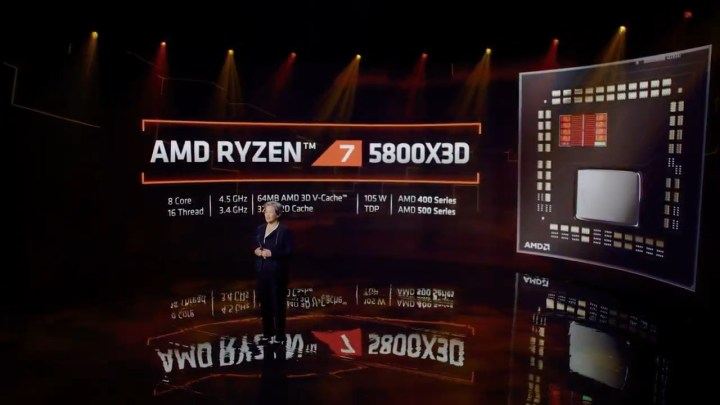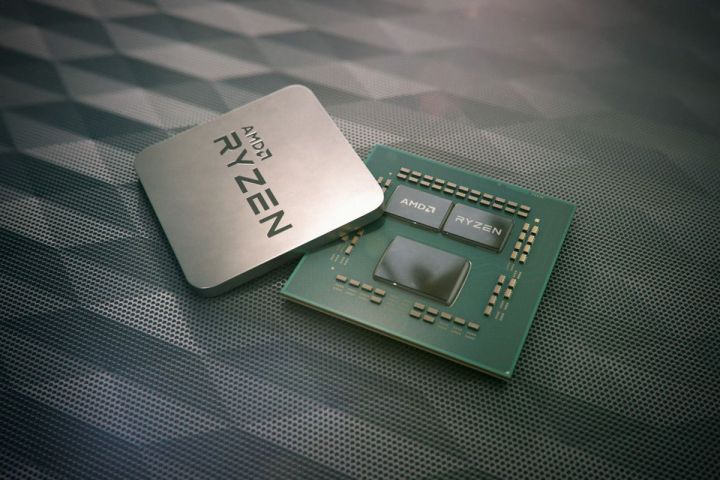AMD launched the Ryzen 7 5800X3D in 2022, bringing the world’s first processor with 3D V-Cache to market. It’s an interesting CPU and sometimes outclasses the more expensive flagships from AMD and Intel. To understand why, you need to get up to speed on what AMD 3D V-Cache is, the performance it offers, and why it’s important.
3D V-Cache could be a major shift for AMD as we stare down Ryzen 7000 processors, and it could have an impact on many generations to come. We’re going to break down if it’s enough to make it to the top of the best processor list or if it’s just marketing hot air.
What is AMD 3D V-Cache?

AMD 3D V-Cache is a packaging technology that stacks additional layers of cache on top of a CPU. It sounds complex, and from an engineering perspective, it is, but it’s not hard to understand what AMD’s tech is doing. Instead of laying the cache next to the processor, as has been traditionally done, AMD is stacking the cache on top to squeeze more on the chip.
It’s a different way to lay out a processor, and thanks to advancements in how CPU makers put components on a chip, AMD is able to squeeze on more cache without making a massive CPU. AMD has only framed the additional cache in the realm of gaming, where the company says it can offer a 15% improvement on average.
To understand why, it’s important to understand what the cache is doing. Your processor has three levels of cache, with the lowest being L3, or level 3, cache. Each cache level is smaller in size but faster in speed, acting as a memory chain to your processor that can serve up instructions as they’re needed.
Think about cache like a supply chain. Your RAM is like a national warehouse, the L3 cache is a regional distribution center, and so on through the L2 and L1 caches. For 3D V-Cache, we’re talking about additional L3 cache, the slowest level on your CPU. That’s only relatively slow, though — each cache layer is still significantly faster than your hard drive or RAM.
More L3 cache allows the processor to stream and store more instructions, decreasing the number of times it needs to pull instructions from RAM. Naturally, this doesn’t provide a performance benefit in all situations. However, in scenarios where the CPU is handling multiple instructions, such as gaming, an additional L3 cache should provide a big uplift.

There are a few reasons why AMD would rather make an entire chip with just cache rather than put more cache in the CPU itself, which has been the norm up to this point. For starters, 3D V-Cache is more customizable and can be added optionally to processors that would actually benefit from it. Although extra cache does have its use outside games, there are many programs that don’t benefit from having more cache, including benchmarks like Cinebench R23.
Cache is also problematic for manufacturing CPUs. One of the key aspects of making CPUs is the process or node, which determines performance, power efficiency, and transistor density characteristics. Newer nodes allow for physically smaller transistors and thus more compact processors, but cache is much more difficult to shrink than other components in a CPU, such as the cores. Since cache doesn’t benefit from being in cutting-edge nodes, it can be cheaper to just make a cache chip on an older and cheaper node.
Right now, we only have one processor that comes with 3D V-Cache: the Ryzen 7 5800X3D. It comes with an additional 64MB of 3D V-Cache, but AMD says its packaging tech can scale up to 192MB (or three V-Cache chips). As 2022 begins and we start looking toward AMD’s Ryzen 7000 CPUs, we’ll likely see a lot more 3D V-Cache.
3D V-Cache processors

3D V-Cache is a technology that should eventually make its way throughout AMD’s product stack. For now, we only have a single processor with it: the Ryzen 7 5800X3D. It launched last spring, and besides clock speed, it’s identical to the Ryzen 7 5800X: eight cores, 16 threads, same architecture, and so on. The big difference is the 64MB of 3D V-Cache, bringing the total L3 cache to 96MB.
AMD has slowly been releasing more 3D V-Cache CPUs, but for its Epyc server CPUs rather than the Ryzen line. There are now four Epyc CPUs with 3D V-Cache, each with a whopping 768MB of L3 cache. These CPUs also have lower clock speeds than their V-cacheless counterparts, just as the 5800X3D has a lower frequency than the 5800X.
Throughout 2022 and beyond, we’ll likely see 3D V-Cache be a cornerstone of AMD’s processor announcements as the technology is now established with the 5800X3D and those 3D V-Cache-enabled Epyc CPUs. AMD has confirmed there will be Ryzen 7000 CPUs with 3D V-Cache, and according to one rumor, the company might bring the technology to its dual-chipset 12- and 16-core flagships, the Ryzen 9 7900X and 7950X.
3D V-Cache performance
In our Ryzen 7 5800X3D review, we found that it was, on average, the fastest gaming CPU available, beating out even the Core i9-12900K by a hair. It was also slightly faster than AMD’s flagship Ryzen 9 5950X, which has 64MB of L3 cache against the 92MB of the 5800X3D.
However, there’s a bit more to the story about why the Ryzen 7 5800X3D is the best gaming CPU than just the average performance.
| AMD Ryzen 7 5800X3D | AMD Ryzen 9 5950X | Intel Core i9-12900K | |
| 3D Mark Time Spy | 17,078 | 17,922 | 19,396 |
| Red Dead Redemption 2 | 119 fps | 127 fps | 132 fps |
| Assassin’s Creed Valhalla | 121 fps | 119 fps | 118 fps |
| Forza Horizon 4 | 247 fps | 234 fps | 250 fps |
| Fortnite | 205 fps | 182 fps | 205 fps |
| Halo Infinite | 127 fps | 119 fps | 113 fps |
| Cyberpunk 2077 | 128 fps | 128 fps | 122 fps |
| Far Cry 6 | 147 fps | 115 fps | 141 fps |
| Civilization VI (turn time, lower is better) | 6.6 seconds | 7.5 seconds | 7.3 seconds |
An interesting outlier was in Red Dead Redemption 2, where the 5800X3D was significantly slower than the 12900K and also the 5950X. This probably wasn’t a benchmarking error but rather a legitimate loss caused by the 5800X3D’s much lower clock speed; the 5800X3D boosts up to just 4.5GHz while the 5950X can achieve 4.9GHz. Clock speed is still a significant factor in CPU gaming performance and can make a big difference in some games. The unfortunate part for V-Cache is that lower clock speeds are unavoidable.
The main drawback of adding 3D V-Cache is seeing a large reduction in maximum voltage for the CPU. Ryzen CPUs rely on high voltages in order to achieve high clock speeds in lightly threaded tasks, and gaming is one of those. This could be particularly problematic for Ryzen 7000, which has much higher clock speeds than Ryzen 5000, and presumably, AMD is using a high amount of voltage to achieve those clock speeds.
Despite all this, 3D V-Cache is a net gain in most games. Red Dead Redemption 2 was an outlier in our testing, and the 5800X3D was otherwise just as fast, if not faster, than the 12900K. Furthermore, Zen 4 (the architecture powering Ryzen 7000) has cache improvements at its very core, with or without V-Cache. Even if Ryzen 7000 CPUs with V-Cache have much lower clock speed than other models, the gains from V-Cache could be worth it.
A packaging revolution?

AMD is making a big deal out of 3D V-Cache, and for good reason. The 5800X3D is able to go toe to toe with much more powerful processors, all because of its large L3 cache. The launch of the Ryzen 3000 in 2019 and the Ryzen 5000 in 2020 strongly indicated that cache was perhaps the most important aspect of CPU gaming performance, and the 5800X3D seems to confirm that.
Without getting too deep in the weeds, Ryzen processors use chiplets instead of a single die. By parting out the components of the processor, AMD chips have a higher latency than their Intel counterparts. To counteract that, AMD includes a large amount of L3 cache and dense interconnects. And when it comes to RAM, faster speeds further improve the situation brought on by AMD’s chiplet architecture design.
3D V-Cache is taking what was meant to counteract a performance deficit and turning it into a performance advantage. More L3 cache doesn’t improve latency (in fact, L3 latency goes up the more you add), but it allows more data to be stored in the CPU instead of the RAM. In turn, that reduces the total latency — the data coming from the RAM and flowing to the CPU — by allowing more of it to stay on the chip before being flushed out.
On a technical level, 3D V-Cache is more than marketing hype. That said, it’s mostly to the benefit of gamers who want to target high frame rates, especially at lower resolutions. The real reason to get excited about 3D V-Cache is AMD’s future processor generations, where architectural improvements and 3D V-Cache together could bring large leaps in performance.
Editors’ Recommendations




